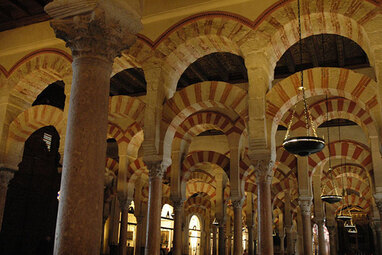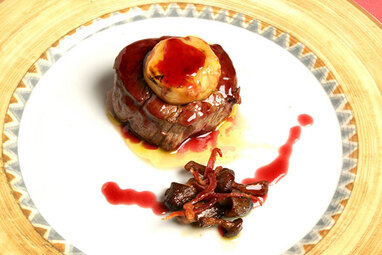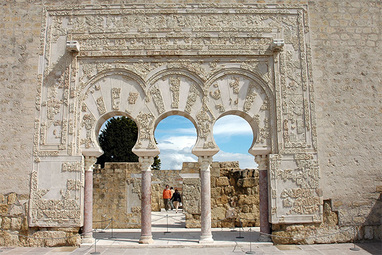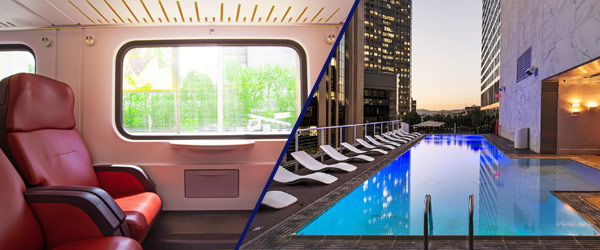
Córdoba
Córdoba
THE CITY

Seneca, Averroes, Maimonides, Abderraman III, Juan de Mena and Luis de Gongora are just some of the famous names associated with Cordoba, a city drowned in pure light and history. Declared a World Heritage Site, many different cultures have settled here, though it was the Moslem period, when it became the capital of Al-Andalus and later the capital of a caliphate which was independent of Damascus, that has left an unequalled experience for visitors to enjoy in one of the largest historical city centres in Europe.
The narrow streets and small squares are also one of the charms of this city which, whether on foot or bicycle, will entrance you with its Cordoban patios full of trees and flowers to bring a sensation of coolness. You will also be conquered by its cuisine, with Roman, Arabic and Jewish influences, to be found in all of the taverns of the city.
Córdoba also holds 4 Inscriptions on the UNESCO World Heritage List: The Mosque (1984), the Historic Center (1994), the Patios Festival, as World Intangible Cultural Heritage (2012) and the Caliphal City of Medina Azahara (2018), what makes Córdoba the european city with more UNESCO inscriptions and the second one in the world, only after Beijing.
NATURE ROUTE IN THE SIERRA DE CORDOBA MOUNTAINS
The province of Cordoba has numerous natural routes and walks. It is one of the most varied areas of the Iberian Peninsula with one nature reserve and three natural parks. The Sierra de Cordoba mountains are just 5 minutes from the city.
ESSENTIALS

The historical legacy in Cordoba can be seen in many of the monuments which cannot be missed if you want to soak in the splendour of the City of the Three Cultures. The Mosque, now the Cathedral of Cordoba, is the most important monument of Islam in the West and one of the most astonishing in the world. Construction began in the year 775 and, over the years, it has been extended many times. Its size and its majestic height inside, which has never been equalled, make it a unique work of art. It is open for visits every day, including Sundays and public holidays.
The Jewish Quarter in Cordoba is a reflection of the Jewish community that, though a minority, was very influential thanks to the professions of the community, which included the teaching of science. Calle de las Flores, Plaza del Pañuelo and Callejon de la Hoguera are especially charming, and a walk through the streets can be rounded off with a visit to the Casa Andalusi, the Casa de Sefarad and the Synagogue, the only one remaining in Andalusia.
Fernandina churches are those which Ferdinand III ordered to be built, many on the site of mosques, in order to eradicate the strong Islamic influence in the city. They are all built with stone walls and two outstanding examples are the Church of Santa Maria, easy to recognise with its great rose window, and the Church of San Miguel.
GET MOVIN!

The historical legacy in Cordoba can be seen in many of the monuments which cannot be missed if you want to soak in the splendour of the City of the Three Cultures. The Mosque, now the Cathedral of Cordoba, is the most important monument of Islam in the West and one of the most astonishing in the world. Construction began in the year 775 and, over the years, it has been extended many times. Its size and its majestic height inside, which has never been equalled, make it a unique work of art. It is open for visits every day, including Sundays and public holidays.
The Jewish Quarter in Cordoba is a reflection of the Jewish community that, though a minority, was very influential thanks to the professions of the community, which included the teaching of science. Calle de las Flores, Plaza del Pañuelo and Callejon de la Hoguera are especially charming, and a walk through the streets can be rounded off with a visit to the Casa Andalusi, the Casa de Sefarad and the Synagogue, the only one remaining in Andalusia.
Fernandina churches are those which Ferdinand III ordered to be built, many on the site of mosques, in order to eradicate the strong Islamic influence in the city. They are all built with stone walls and two outstanding examples are the Church of Santa Maria, easy to recognise with its great rose window, and the Church of San Miguel.
ALTERNATIVES

Equestrian shows are one of the very special, very different activities that you will find in Cordoba. Ideal for all the family, the Caballerizas Reales, or Royal Stables, offer a spectacular experience with purebred Andalusian horses for between 10 and 15 euros. Night-time visits to the Mosque-Cathedral called “The Soul of Cordoba”, and the Water, Light and Sound show at the Alcazar of the Christian Monarchs, called “Cordoba, the Light of the Cultures”, are an unmissable part of this nocturnal offer.
Cordoba is also the perfect place to relax, and it does so recalling its past. The Hamman, or Arabic baths, are to be found in the Jewish Quarter, where, as well as taking a bath in the old Andalusi tradition, you can also delight in the taste of the Arabic teas and pastries, which are very popular in the many tea shops of the city.
And, carrying on with the traditions, at night, do not hesitate to visit the tablaos, flamenco shows, which are to be found in the centre of the city, such as El Cardenal, La Buleria, La Pataita de Antonio and Perol Flamenco. Dance, singing, music… pure flamenco art that will leave no-one unmoved.
FLAVOURS

Olive oil, wine, meat and cured sausages are the stars of Cordoban cuisine. The nearby mountains provide the game and the countryside and the Guadalquivir Valley produce the olive oil, vegetables and Montilla-Moriles wines.
These ingredients go into the making of the succulent delicacies characteristic of Cordoba, such as Cordoban salmorejo (a thick tomato-based summer soup), that is served as a starter in all of the bars, the boquerones en vinagre (anchovies marinated in vinegar), a can’t-miss tapa, the rabo de toro (bull’s tail), an internationally renowned dish that also reflects the bullfighting tradition of the city, and the flamenquín de jamón serrano (deep-fried flutes of cured Spanish ham), normally served with home-made mayonnaise and French fries.
If you still have room for dessert, try the pastel cordobés, with a very strong Arabic influence. And wash it down with a glass of sweet Pedro Ximenez, a magnificent example of the local wines.
DON’T MISS

The twisting streets of the Jewish Quarter monopolise the souvenir trade, with the Cordoban hat as the leading emblem. But you can also find places, like the Zoco, or Souk, to shop for local handicrafts: leatherwork, silver or ceramics decorated with allegorical motifs of Islamic Cordoba.
Around the Plaza de las Tendillas is the modern Cordoba, of the last century, with pleasant pedestrian streets such as Calle Gondomar and Calle Jose Cruz Conde, where you will find the most prestigious shops in the city. Cordoba also boasts the Parque Joyero, an area devoted entirely to the production of jewellery, making the city one of the leading manufacturers in the sector.








